Professional astronomers have got some powerful equipment at their disposal: Hubble, Keck, and Spitzer, just to name a few. But many discoveries rely on the work of amateurs, using equipment you could buy at your local telescope shop. And recently, amateurs helped discover a planet orbiting another star 15 thousand light-years away. Grant Christie is an amateur astronomer from Auckland New Zealand, and is part of the team that made the discovery.
Continue reading “Podcast: Amateurs Help Find a Planet”
Audio: Amateurs Help Find a Planet
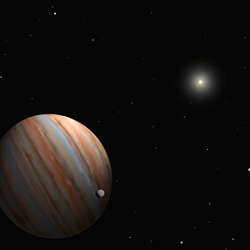
Artist illustration of an extrasolar planet. Image credit: CfA. Click to enlarge.
Listen to the interview: Microlens Planet Discovery (6.2 mb)
Or subscribe to the Podcast: universetoday.com/audio.xml
Fraser Cain: Can you give me some background on the planet that you helped to discover?
Grant Christie: There’s still a bit of analysis to do on it to figure out exactly all its parameters, but it’s in the order of about 15,000 light-years away. That’s still being worked on, the distance. It’s quite a massive planet, probably in the order of about 2-3x the mass of Jupiter, and it’s orbiting at about 3 astronomical units away from its parent star. It’s not exactly like a familiar object, but if you could see it up close, it would probably look a bit like Jupiter. It would be about 3 times heavier, but not that much bigger because it would be more compressed by its gravity.
Fraser: The planets that have been discovered to date are within a few hundred light years of Earth. How were you able to find one 15,000 light-years away, expecially using backyard equipment?
Christie: With this discovery, we’re just part of a cog in a wheel, we’re part of a team, but it was using a method known as gravitational microlensing. That sounds like a bit of a mouthful, but essentially it uses a star as a lens to magnify a more distant star. This works if the two stars are exactly lined up as we see them from Earth. So we have a situation where we have a distant star somewhere in the halo – or the bulge – of the galaxy maybe 20,000 light-years from Earth. By chance, another star has come almost exactly in line between us and it. That intervening star’s gravity works like a lens and it amplifies the light of the more distant star. We can’t see them as two stars, they’re so close together, and no telescope on Earth can. But what we see is the magnification, or the amplification of the light from the distant star as it goes through that lens. All of that’s fine, some 600 of these microlensing events are detected each year currently. They in themselves aren’t that unusual, but it turns out that if you have a planet orbiting the lensing star – the one that’s intervened between us and the more distant one – then that planet hugely changes the characteristics of the lens. It changes the light amplification greatly. What we’re doing is simply measuring the brightness changes of the lens as these two stars come into alignment and then move out of alignment. It turns out that the one we were observing, the light was magnified by something like 50x over and above what was there before the lensing started. That brings faint stars that we normally couldn’t see with a small telescope up within our range. In the current case, the amplification brought it up to magnitude 18 in the visual wavelengths. That’s very close to our limit, but we were still able to do it.
Fraser: Was your team expecting to find evidence of a planet before you began any observations, or was that just a happy outcome?
Christie: It is largely a happy outcome. There’s a team based in Chile, a Polish team from Warsaw University let by Professor Udalski, and their job, their main function is to find microlensing events. They monitor millions of stars every night looking for stars that just seem to rise in brightness in a way that you’d expect from a lens. There are obviously lots of variable stars as well, which they have already tabulated, so they know about those. They’re detecting microlensing events. They’re detecting about 600 a year. They started observing this event in about March 17th, or thereabouts, and they noticed this star just starting to brighten – it had never brightened before – and they followed it. Each night as they took an observation, it appeared to brighten more and more, and as this process goes on they noticed that it was following a particular brightening curve that you’d expect from a microlensing event, so they were confident that it was a microlens. And then as we got closer into April, it started to show signs that it was departing from a pure simple lens you’d get from a single star all by itself; that’s a mathematically defined shape and if the photometry’s good, you can usually tell whether you’ve got a single lens or not. Around April 18th they started to notice a significant departure from that simple lens model, these are the guys running the OGLE team. They put out an alert that went to MicroFUN, who is a group we’re associated with. They run out of Ohio State University, led by Professor Andrew Gould there. We then received notification saying, it looks like there might be an anomoly with this microlensing event; try and observe it as much as possible. That’s really where we started our observations. By that stage it was faint, but it was still within reach of our telescopes. We were surprised that it actually was observable. I would have thought that it was too faint. Now I know that we can do work at a fainter limit than I’d previously thought. It was known by about April 20th that this microlensing event had a strong anomaly in it, which is the term they use, and we followed it for the following few days – probably about 3-4 days. It went through some very strong anomalies that really were a sign that was a planet present causing those anomolies. Most of these events you observe – I’ve done quite a few, probably 20 at least myself – turn out to be a simple lens, and there’s nothing surprising in them at all. The excitement of doing this sort of work is that you simply don’t know, nobody knows what you’re going to find. You start following one of these microlensing events as it reaches its maximum, and it’s at the maximum point, or close to it when the maximum sensitivity to a planet is going to be. We’re just not that interested in looking at them until you get very close to that maximum. And that’s when the networks really come are really start to saturate the light curve by covering them.
Fraser: So the stars have to be lined up quite nicely for the effect of the planet to show up.
Christie: Yes, they need to be nearly perfect. That creates a very high amplification. Some of the ones we’ve looked at have had amplifications where the light is magnified 800x. They’re not common, but when you get a very high amplification lens like that, when the alignment is nearly perfect, that’s when you’re most likely to find a planet if there’s one present.
Fraser: How sensitive can this technique be?
Christie: Some of the experts have said that had this planet not been bigger than Jupiter, it was the size of the Earth, these observations still would have detected it. I know there’s some debate about that amongst the academics in the teams, but broadly speaking, that’s probably an indication that this method can be very sensitive. And this event actually didn’t come up to be that bright. We’ve observed ones which have come up so bright you could see them in a little 6″ telescope.
Fraser: That’s amazing, though. I know people have been discussing different techniques that they might be able to see Earth-sized planets orbiting other stars, but to know that we might have a technique available right now is pretty impressive. I wanted to talk to you a bit about how amateurs can get involved in the discoveries in astronomy. Where are some avenues that people can get involved?
Christie: There are lots of ways you can get involved in observational astronomy, but in talking about photometry, which is a measurement of star brightness, you basically just need a telescope with as much aperture as you can afford. A decent sort of mounting and a CCD imaging camera. For below $10,000 you can set up a system that’s very capable, and can actually be really useful. There are lots of other things you can do in observational astronomy that don’t require that, but to do this sort of work, that’s what you’d need. We do work other than this microlensing work, we also measure the light changes of objects called cataclysmic variable stars. These are interesting objects that do a lot of flickering, and all sorts of things, and we’re part of a worldwide network that follows that kind of object. Generally, the common denomenator is the measurement of brightness over time of some star or object. That’s called photometry, and that’s primarily what we do.
Fraser: Congratulations on your team’s discovery of this new planet, and good luck with your work in the future.
Christie: You’re very welcome. I’d like to pay tribute to my co-worker here in New Zealand, Jennie McCormick, who uses the smallest telescope of all, and has done way over a thousand hours on this kind of work and deserves the recognition from her efforts put in.
Saturn Reflects X-Rays from the Sun
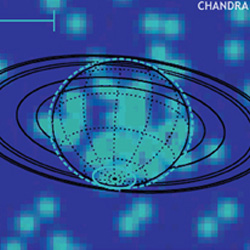
Saturn viewed by Chandra in the X-Ray spectrum during a solar flare. Image credit: Chandra. Click to enlarge.
When it comes to mysterious X-rays from Saturn, the ringed planet may act as a mirror, reflecting explosive activity from the sun, according to scientists using NASA’s Chandra X-ray Observatory.
The findings stem from the first observation of an X-ray flare reflected from Saturn’s low-latitudes, the region that correlates to Earth’s equator and tropics.
Dr. Anil Bhardwaj, a planetary scientist at NASA’s Marshall Space Flight Center (MSFC), Huntsville, Ala., led the study team. The study revealed Saturn acts as a diffuse mirror for solar X-rays.
Counting photons, particles that carry electromagnetic energy including X-rays, was critical to this discovery. Previous studies revealed Jupiter, with a diameter 11 times that of Earth, behaves in a similar fashion. Saturn is about 9.5 times larger than Earth. It is twice as far from Earth as Jupiter.
“The bigger the planet and nearer to the sun, the more solar photons it will intercept; resulting in more reflected X-rays.” Bhardwaj said. “These results imply we could use giant planets like Jupiter and Saturn as remote-sensing tools. By reflecting solar activity back to us, they could help us monitor X-ray flaring on portions of the sun facing away from Earth’s space satellites.”
Massive solar explosions called flares often accompany coronal mass ejections, which emit solar material and a magnetic field. When directed toward Earth, these ejections can wreak havoc on communications’ systems from cell phones to satellites.
Even as the research appeared to solve one mystery, the source of Saturn’s X-rays, it fueled long standing questions about magnetic fields. Of the three magnetic planets in our solar system, Jupiter and Earth emit two general types of X rays, auroral emissions from polar regions and disk emissions from low latitudes. No research has observed unambiguous signatures of auroral X-ray emissions on Saturn.
“We were surprised to find no clear evidence of auroral X-ray emissions during our observations,” Bhardwaj said. “It is interesting to note that even as research solves some mysteries, it confirms there is much more we have to learn.”
The research appeared in the May 10, 2005 issue of Astrophysical J. Letters. the research team also included Ron Elsner of MSFC; Hunter Waite of the University of Michigan, Ann Arbor; Randy Gladstone of the Southwest Research Institute, San Antonio, Texas; Thomas Cravens of the University of Kansas, Lawrence; and Peter Ford from the Massachusetts Institute of Technology, Cambridge.
Bhardwaj is working at MSFC as a National Research Council scholar. MSFC manages the Chandra program for NASA’s Science Mission Directorate in Washington. Northrop Grumman of Redondo Beach, Calif., was the prime development contractor for the observatory. The Smithsonian Astrophysical Observatory controls science and flight operations from the Chandra X-ray Center in Cambridge, Mass.
Original Source: NASA News Release
Opportunity Still Working Itself Free from the Sand
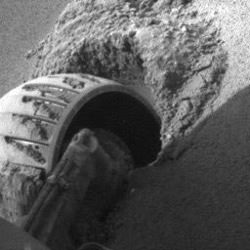
Opportunity’s self-portrait, showing its wheel in the sand. Image credit: NASA/JPL. Click to enlarge.
NASA’s Mars rover Opportunity is trying to escape from a sand trap, while its twin, Spirit, has been busy finding new clues to a wet and violent early Martian history.
“Spirit has finally found the kind of geology you can really sink your teeth into,” said Dr. Steve Squyres of Cornell University, Ithaca, N.Y. He is principal investigator for the Mars rovers’ science instruments. According to Squyres, multiple layers of rock in the hills Spirit is exploring suggest successive deposits of water-altered explosive debris.
Spirit, inside Mars’ Gusev Crater, had to share the spotlight with the drama provided by Opportunity on the martian Meridiani plains. The rover has been hindered by soft sand for nearly three weeks. Traction is difficult in the ripple-shaped dune of windblown dust and sand that Opportunity drove into on April 26. Since it began trying to get out, the rover has advanced only 11 inches. Without the slippage caused by the rover’s wheels spinning in the soft sand, Opportunity could have driven 157 feet.
“If Opportunity gets free, its next task will be examining the site to give the rover team a better understanding of how this ripple differs from dozens Opportunity easily crossed,” said Jim Erickson. He is project manager for the Mars Exploration Rover project at NASA’s Jet Propulsion Laboratory, Pasadena, Calif.
The rovers have worked under harsh martian conditions longer than expected. They have been studying geology on opposite sides of Mars for more than a year since successfully completing their three-month primary missions. Shortly after landing in January 2004, Opportunity found layered bedrock bearing geological evidence of a shallow ancient sea. More than one year later, Spirit found extensive layered bedrock after driving more than two miles and climbing into the “Columbia Hills.”
Squyres said, “In the last few weeks, we have gone from a state of confusion about the geology of the “Columbia Hills” to having real stratigraphic sequence and a powerful working hypothesis for the history of these layers.”
For several months, Spirit climbed a flank of “Husband Hill,” the tallest in the range. The slope closely matched the angle of underlying rock layers, which made the layering difficult to detect. Spirit reached an intermediate destination, dubbed “Larry’s Lookout,” then continued uphill and looked back. “That was the critical moment, when it all began falling into place,” Squyres said. “Looking back downhill, you can see the layering, and it suddenly starts to makes sense.”
Spirit has been examining rocks in a series of outcrops called “Methuselah,” “Jibsheet” and “Larry’s Lookout.” Some of the rocks contain the mineral ilmenite, not found previously by Spirit. “Ilmenite is a titanium-iron oxide formed during crystallization of magma,” said Dr. Dick Morris, a rover science-team member at NASA’s Johnson Space Center, Houston. “Its occurrence is evidence for diversity in the volcanic rocks in the Gusev region.”
Rocks from different layers share compositional traits, high in titanium and low in chromium, which suggests a shared origin. However, the degree to which minerals in rocks have been chemically altered by exposure to water or other processes varies greatly from outcrop to outcrop. The textures also vary. At Methuselah, rocks have thin laminations revealed by Spirit’s microscopic imager. At Jibsheet, they are built of bulbous grains packed together. At Larry’s Lookout, the rocks are massive, with little fine-scale structure.
“Our best hypothesis is we’re looking at a stack of ash or debris that was explosively erupted from volcanoes and settled down in different ways,” Squyres said. “We can’t fully rule out the possibility the debris was generated in impact explosions instead of volcanic ones. But we can say, once upon a time, Gusev was a pretty violent place. Big, explosive events were happening, and there was a lot of water around.”
Rover-team scientists described the robot explorers’ activities today at the spring meeting of the American Geophysical Union in New Orleans. For images and information about the rovers and their discoveries, visit: http://www.nasa.gov/vision/universe/solarsystem/mer_main.html.
Original Source: NASA/JPL News Release
A Bend in the Rings
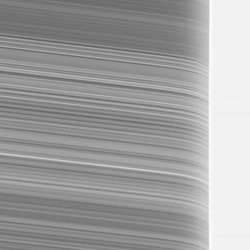
Saturn’s atmosphere makes the rings look like they’re bending just as they pass behind the planet. Image credit: NASA/JPL/SSI. Click to enlarge.
Saturn’s rings appear strangely warped in this view of the rings seen through the upper Saturn atmosphere.
The atmosphere acts like a lens in refracting (bending) the light reflected from the rings. As the rings pass behind the overexposed limb (edge) of Saturn as seen from Cassini, the ring structure appears to curve downward due to the bending of the light as it passes through the upper atmosphere.
This image was obtained using a near-infrared filter. The filter samples a wavelength where methane gas does not absorb light, thus making the far-off rings visible through the upper atmosphere.
By comparing this image to similar ones taken using filters where methane gas does absorb, scientists can estimate the vertical profile of haze and the abundance of methane in Saturn’s high atmosphere.
The image was taken in visible light with the Cassini spacecraft narrow-angle camera on April 14, 2005, through a filter sensitive to wavelengths of infrared light centered at 938 nanometers and at a distance of approximately 197,000 kilometers (123,000 miles) from Saturn. The image scale is 820 meters (2,680 feet) per pixel.
The Cassini-Huygens mission is a cooperative project of NASA, the European Space Agency and the Italian Space Agency. The Jet Propulsion Laboratory, a division of the California Institute of Technology in Pasadena, manages the mission for NASA’s Science Mission Directorate, Washington, D.C. The Cassini orbiter and its two onboard cameras were designed, developed and assembled at JPL. The imaging team is based at the Space Science Institute, Boulder, Colo.
For more information about the Cassini-Huygens mission visit http://saturn.jpl.nasa.gov . For additional images visit the Cassini imaging team homepage http://ciclops.org .
Original Source: NASA/JPL/SSI News Release
Voyager 1 Enters the Heliosheath
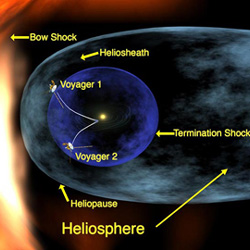
Artist illustration of the position of the twin Voyager spacecraft. Image credit: NASA/JPL. Click to enlarge.
NASA’s Voyager 1 spacecraft has entered the solar system’s final frontier. It is entering a vast, turbulent expanse where the Sun’s influence ends and the solar wind crashes into the thin gas between stars.
“Voyager 1 has entered the final lap on its race to the edge of interstellar space,” said Dr. Edward Stone, Voyager project scientist at the California Institute of Technology in Pasadena. Caltech manages NASA’s Jet Propulsion Laboratory in Pasadena, which built and operates Voyager 1 and its twin, Voyager 2.
In November 2003, the Voyager team announced it was seeing events unlike any in the mission’s then 26-year history. The team believed the unusual events indicated Voyager 1 was approaching a strange region of space, likely the beginning of this new frontier called the termination shock region. There was considerable controversy over whether Voyager 1 had indeed encountered the termination shock or was just getting close.
The termination shock is where the solar wind, a thin stream of electrically charged gas blowing continuously outward from the Sun, is slowed by pressure from gas between the stars. At the termination shock, the solar wind slows abruptly from a speed that ranges from 700,000 to 1.5 million miles per hour and becomes denser and hotter. The consensus of the team is that Voyager 1, at approximately 8.7 billion miles from the Sun, has at last entered the heliosheath, the region beyond the termination shock.
Predicting the location of the termination shock was hard, because the precise conditions in interstellar space are unknown. Also, changes in the speed and pressure of the solar wind cause the termination shock to expand, contract and ripple.
The most persuasive evidence that Voyager 1 crossed the termination shock is its measurement of a sudden increase in the strength of the magnetic field carried by the solar wind, combined with an inferred decrease in its speed. This happens whenever the solar wind slows down.
In December 2004, the Voyager 1 dual magnetometers observed the magnetic field strength suddenly increasing by a factor of approximately 2-1/2, as expected when the solar wind slows down. The magnetic field has remained at these high levels since December. NASA’s Goddard Space Flight Center, Greenbelt, Md., built the magnetometers.
Voyager 1 also observed an increase in the number of high-speed electrically charged electrons and ions and a burst of plasma wave noise before the shock. This would be expected if Voyager 1 passed the termination shock. The shock naturally accelerates electrically charged particles that bounce back and forth between the fast and slow winds on opposite sides of the shock, and these particles can generate plasma waves.
“Voyager’s observations over the past few years show the termination shock is far more complicated than anyone thought,” said Dr. Eric Christian, Discipline Scientist for the Sun-Solar System Connection research program at NASA Headquarters, Washington.
The result is being presented today at a press conference in the Morial Convention Center, New Orleans, during the 2005 Joint Assembly meeting of Earth and space science organizations.
For their original missions to Jupiter and Saturn, Voyager 1 and sister spacecraft Voyager 2 were destined for regions of space far from the Sun where solar panels would not be feasible, so each was equipped with three radioisotope thermoelectric generators to produce electrical power for the spacecraft systems and instruments. Still operating in remote, cold and dark conditions 27 years later, the Voyagers owe their longevity to these Department of Energy-provided generators, which produce electricity from the heat generated by the natural decay of plutonium dioxide.
Original Source: NASA/JPL News Release
Powerful Flare Shook Up Our Understanding of the Sun
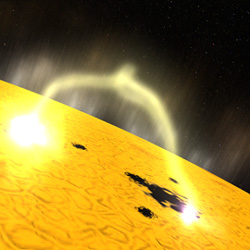
Artist illustration of magnetic lines stretching and twisting around sunspots. Image credit: NASA. Click to enlarge.
The most intense burst of solar radiation in five decades accompanied a large solar flare on January 20. It shook space weather theory and highlighted the need for new forecasting techniques, according to several presentations at the American Geophysical Union (AGU) meeting this week in New Orleans.
The solar flare, which occurred at 2 a.m. EST, tripped radiation monitors all over the planet and scrambled detectors on spacecraft. The shower of energetic protons came minutes after the first sign of the flare. This flare was an extreme example of the type of radiation storm that arrives too quickly to warn interplanetary astronauts.
“This flare produced the largest solar radiation signal on the ground in nearly 50 years,” said Dr. Richard Mewaldt of the California Institute of Technology, Pasadena, Calif. He is a co-investigator on NASA’s Advanced Composition Explorer (ACE) spacecraft. “But we were really surprised when we saw how fast the particles reached their peak intensity and arrived at Earth.”
Normally it takes two or more hours for a dangerous proton shower to reach maximum intensity at Earth after a solar flare. The particles from the January 20 flare peaked about 15 minutes after the first sign.
“That’s important because it’s too fast to respond with much warning to astronauts or spacecraft that might be outside Earth’s protective magnetosphere,” Mewaldt said. “In addition to monitoring the sun, we need to develop the ability to predict flares in advance if we are going to send humans to explore our solar system.”
The event shakes the theory about the origin of proton storms at Earth. “Since about 1990, we’ve believed proton storms at Earth are caused by shock waves in the inner solar system as coronal mass ejections plow through interplanetary space,” said Professor Robert Lin of the University of California at Berkeley. He is principal investigator for the Reuven Ramaty High Energy Solar Spectroscopic Imager (RHESSI). “But the protons from this event may have come from the sun itself, which is very confusing.”
The origin of the protons is imprinted in their energy spectrum, as measured by ACE and other spacecraft, which matches the energy spectrum of gamma-rays thrown off by the flare, as measured by RHESSI. “This is surprising because in the past we believed the protons making gamma-rays at the flare were produced locally and the ones at the Earth were produced instead by shock acceleration in interplanetary space,” Lin said. “The similarity of the spectra suggests they are the same.”
Solar flares and coronal mass ejections (CMEs), associated giant clouds of plasma in space, are the largest explosions in the solar system. They are caused by the buildup and sudden release of magnetic stress in the solar atmosphere above the giant magnetic poles we see as sunspots. The Transitional Region and Coronal Explorer (TRACE) and the Solar and Heliospheric Observatory (SOHO) spacecraft are devoted to observing the sun and identifying the root causes of flares and CMEs, with an eye toward forecasting them.
“We do not know how to predict the flow of energy into and through these large flares”, said Dr. Richard Nightingale of the Lockheed Martin Solar and Astrophysics Laboratory in Palo Alta, Calif. “Instruments like TRACE give us new clues with each event we observe.”
TRACE has identified a possible source of the magnetic stress that causes solar flares. The sunspots that give off the very largest (X-class) flares appear to rotate in the days around the flare. “This rotation stretches and twists the magnetic field lines over the sunspots”, Nightingale said. “We have seen it before virtually every X-flare that TRACE has observed since it was launched and more than half of all flares in that time.”
However, rotating sunspots are not the whole story. The unique flare came at the end of a string of five other very large flares from the same sunspot group, and no one knows why this one produced more sudden high energy particles than the first four.
“It means we really don’t understand how the sun works,” Lin said. “We need to continue to operate and exploit our fleet of solar-observing spacecraft to identify how it works.”
Original Source: NASA News Release
Audio: Unlikely Wormholes
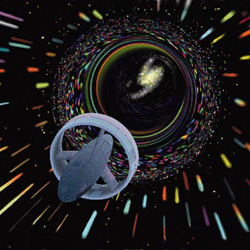
Artist illustration of a spacecraft passing through a wormhole to a distant galaxy. Image credit: NASA. Click to enlarge.
Listen to the interview: Unlikely Wormholes (4.5 mb)
Or subscribe to the Podcast: universetoday.com/audio.xml
Fraser Cain: Now, I’ve watched my share of Star Trek episodes. How well has this prepared me for the actual scientific understanding of a wormhole?
Dr. Stephen Hsu: In Star Trek they don’t really use wormholes, but maybe the best treatment in sci-fi for wormholes was in the movie Contact, which is based on a book by Carl Sagan. And actually historically, when Sagan was writing the novel – Sagan was an astronomy professor – he contacted an expert in General Relativity, a guy named Kip Thorne, at Caltech, and wanted to make sure that the way wormholes were treated in Contact was actually as close to being scientifically correct as possible. And that actually stimulated Thorne to do a lot of research on wormholes. Our work is actually an extension of things that he did.
Fraser: So if you wanted to build a wormhole, theoretically, what would you do?
Hsu: You need to have a very weird or exotic kind of matter and that matter has to have highly negative pressure. It turns out that to stabilize the throat or the tube of the wormhole you need very strange matter and our work has to do with how possible that kind of matter would be in models of particle physics.
Fraser: Let’s say you build a tear in spacetime and you fill it with exotic matter to keep it open, and then you could move the two end points of the wormhole around the Universe and they would connect both in space and in time.
Hsu: But in some science fiction stories they postulate that there are just some wormholes left over from the Big Bang, and we would just discover one and start using it. But the constructive model is that humans, or some alien civilization, actually build their own, and in that case the two ends of the wormhole probably are pretty close together at the beginning but then you pull them apart.
Fraser: Where has your research led you to look at wormholes?
Hsu: We were studying fundamental constraints on something called the “equation of state of matter” – what properties, like pressure or energy density can matter have. We found some very strong constraints, and it turns out those constraints are very negative for the possibility of building a wormhole.
Fraser: What effect will they have on the wormhole?
Hsu: To get the very weird exotic matter that I mentioned before with very negative pressure, it turns out the equations show that when you force the pressure to be that negative, there always some unstable mode in the matter, which means that if you were to bump your apparatus, you might find the exotic matter – which is stabilizing the wormhole – just collapses into a bunch of photos or something.
Fraser: Is it a matter of not bumping your apparatus, or is it theoretically impossible to reach a stable point?
Hsu: I would say it’s theoretically impossible to build classical matter which is stable and can stabilize a wormhole. You might ask, well maybe I’ll just avoid bumping the thing, but if you were to send a person through the wormhole, that itself would provide a bump and would very likely cause the whole thing to fall apart.
Fraser: Let’s say you didn’t want to send people, you just wanted some way of sending information – talking back in time.
Hsu: That’s not excluded. It turns out the constraints we derive have to do with matter in which quantum effects are relatively small. If you have matter in which quantum effects are very big, then you could still have a stable wormhole. The wormhole itself would be fuzzy in a quantum way. The tube of the wormhole would be fluctuating like a quantum state. Now, that doesn’t prevent you from sending a message back in time; you might have to try to send the message many times to get it to go where you want it to go. But, perhaps you could still send a message. Sending a person might be dangerous if the wormhole is fluctuating because the person might end up in the wrong place or the wrong time.
Fraser: I’d heard estimations that building a wormhole would require more energy than the entire Universe. Have you got some kind of calculations to that effect?
Hsu: Our calculations don’t necessarily show that. It does take a tremendous amount of energy density to create a wormhole which is big enough for a human to fit through. But, usually considering this kind of problem, you assume that whatever civilization is trying to do this has arbitrarily advanced technology. What we’re trying to understand is whether there’s a limitation not coming from technology but really coming from the fundamental laws of physics.
Fraser: And where will your research lead you from this point on? Is there something that you’re still a little unsure about?
Hsu: Our result mainly has to deal with the classical wormholes, or wormholes whose spacetime is not very quantum mechanical, and we’re still interested to see if we can extend our results to cover wormholes in which spacetime is fuzzy.
Fraser: There’s some new work on dark energy where they’re saying that the dark energy effect seems to be happening in the Universe, that it’s accelerating. Either there’s a new form of energy that’s not been seen before, or maybe it’s a breakdown in Einstein’s theories at a large level. If some of that work starts to show that maybe Einstein’s relativity isn’t able to explain it at the larger level, will it have an implication on the classical understanding of what a wormhole is?
Hsu: In the context of dark energy, since it’s something that affects the large scale structure of the Universe, the behaviour of the Universe on length scales of megaparsecs, it’s always possible that General Relativity as a theory is modified at very large distances and because we haven’t been able to test it on those distances. So it’s always possible that conclusions you get from Relativity are just not applicable. In our case, the length scale over which we’re using General Relativity is on the size of a human. So, it would be somewhat surprising if General Relativity were to break down already at those length scales, though it’s possible.
Fraser: So it’s more on the small side what you’re looking at. It still explains things quite nicely at this scale.
Hsu: Right, there are stronger experimental tests of General Relativity, or at least Newtonian gravity, on length scales of metres than on megaparsecs. So we’re a little more confident that the mathematical formulation of gravity that we’re using is correct.
Fraser: If I wanted to get across the Universe quite rapidly, I should look perhaps to the warp drive instead, or maybe just plain old moving in regular space.
Hsu: I’m a huge science fiction fan, and have been since I was a kid, but as a scientist, I’d have to say it’s looking like our Universe seems to not be constructed in a very convenient way for humans to get from star to star. And the sci-fi which we end up staying close to our Sun, but we do amazing things with bioengineering or information technology or A.I. seem more likely to be realizable with our physical laws, than Star Trek.
Cassini Determines the Density of Saturn’s Rings
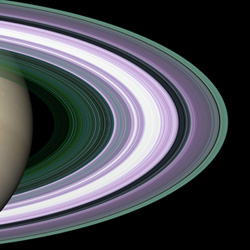
Cassini image of Saturn’s rings enhanced in false colours. Image credit: NASA/JPL/SSI. Click to enlarge.
The Cassini spacecraft has obtained the most detailed look ever at Saturn’s rings, including the B ring, which has eluded previous robotic explorers. Its structure seems remarkably different from its two neighbors, rings A and C.
The origin of Saturn’s rings is a mystery. The rings are an enormous, complex structure. From edge-to-edge, the ring system would not even fit in the distance between Earth and the Moon. The seven main rings are labeled in the order they were discovered. From the planet outward, they are D, C, B, A, F, G and E.
During a recent radio experiment, Cassini mapped this structure with clarity never before available. This is the first of many such observations Cassini will be conducting over the summer.
“The structure of those remarkable rings is a sight to behold. All ring features appear to be populated by a broad range of particle sizes that extend to many meters in diameter at the upper end,” said Dr. Essam Marouf, Cassini radio science team member and professor of electrical engineering, San Jose State University, San Jose, Calif.
Marouf said that at the lower end, particles of about 5 centimeters (roughly 2 inches) in diameter or less seem to be scarce in ring B and inner ring A. In rings C and outer ring A, particles of less than about 5 centimeters (2 inches) in diameter seem to be abundant.
Cassini found that the inner and outer parts of ring B contain rings that are hundreds of kilometers wide (hundreds of miles) and vary greatly in the amount of material they contain. A thick, 5,000-kilometer-wide (3,100-mile) core contains several bands with ring material that is nearly four times as dense as that of ring A and nearly 20 times as dense as that of ring C.
The dramatically varying structure of ring B is in sharp contrast to the relatively flat structure of ring A or the gentle, wavy structure of ring C, where many dense, narrow and sharp-edged ringlets permeate its outer part.
Cassini also detected more than 40 wavy features called “density waves” in ring A, many near its outer region, close to the moons orbiting just outside the ring. The density wave observations will tell more about the ring surface mass density, its vertical thickness and other physical properties.
“A marvelous array of waves, caused by gravitational interactions with nearby moons, has been uncovered throughout ring A,” said Marouf. “We also see a major density wave in the dense ring B. Some of these waves have been seen in Voyager and other Cassini observations, but not in this large number and not with this exceptional clarity.”
Cassini conducted this first radio occultation observation of Saturn’s rings, atmosphere and ionosphere on May 3, 2005. An occultation means that if you watch Cassini from Earth, Cassini would appear occulted, or hidden, behind the rings. During a radio occultation, Cassini sends a radio signal from the spacecraft through the rings to Earth. Scientists then watch how the strength of the radio signal is affected as the signal passes through ring material. The denser a ring is, the weaker the signal received. The experiment helps scientists map the distribution of the amount of ring material and determine the ring particle sizes.
The occultation was the first ever to use three radio signals of different frequencies (called Ka, X and S) transmitted simultaneously from a spacecraft to Earth-receiving stations of NASA’s Deep Space Network. Ring particles of different sizes affect each frequency differently.
The Cassini tour was specifically designed to optimize the geometry of the first radio occultation experiment and seven other occultations scheduled from May to September 2005. These observations are at the heart of Cassini’s fundamental science objectives of characterizing and understanding Saturn and its ring system. During its lifetime, Cassini will obtain 20 radio occultations and 80 stellar occultations, providing far more detailed knowledge of the ring structures.
For images and information on the Cassini mission visit http://saturn.jpl.nasa.gov and http://www.nasa.gov/cassini .
The Cassini-Huygens mission is a cooperative project of NASA, the European Space Agency and the Italian Space Agency. The Jet Propulsion Laboratory, a division of the California Institute of Technology in Pasadena, manages the Cassini-Huygens mission for NASA’s Science Mission Directorate, Washington, D.C. The Cassini orbiter was designed, developed and assembled at JPL.
Original Source: NASA/JPL News Release
Podcast: Unlikely Wormholes
Wormholes are a mainstay in science fiction, providing our heroes with a quick and easy way to instantly travel around the Universe. Enter a wormhole near the Earth and you come out on the other side of the galaxy. Even though science fiction made them popular, wormholes had their origins in science – distorting spacetime like this was theoretically possible. But according to Dr. Stephen Hsu from the University of Oregon building a wormhole is probably impossible.
Continue reading “Podcast: Unlikely Wormholes”
